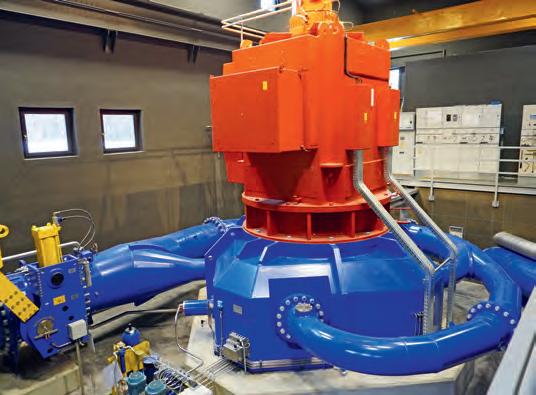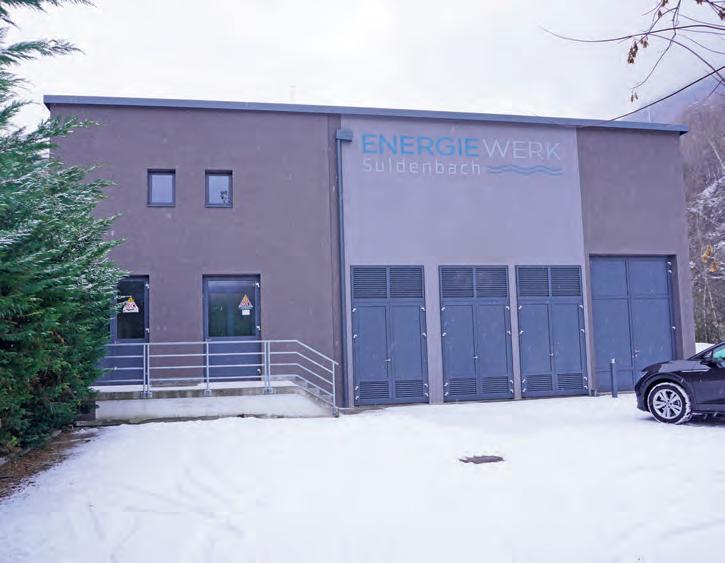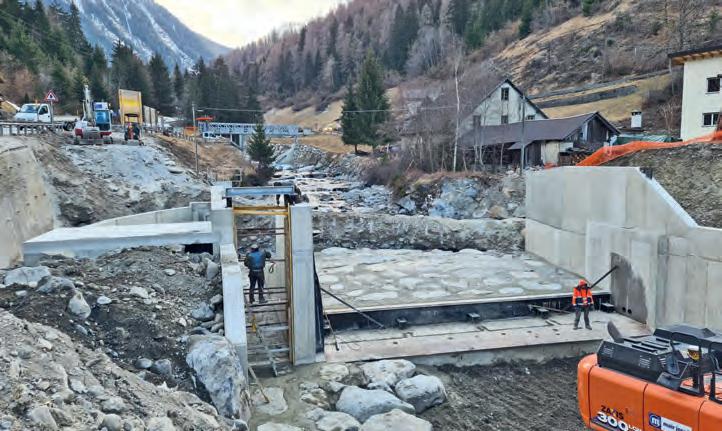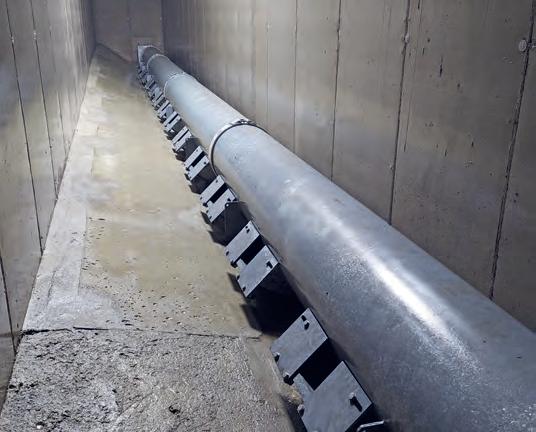
6 minute read
NEW ITALIAN SMALL-SCALE POWER STATION IMPLEMENTED AS PART OF A WIDE-RANGING SYNERGY PROJECT
from zek HYDRO 2023
by zek Magazin
In a way, it was the idea of killing several birds with one stone that inspired the latest process water project at the Stilfser Joch national park in South Tyrol in the Italian-Swiss-Austrian tri-border region. Based on a complete redesign of an existing power station on the Suldenbach by the local EnergieWerk-Prad cooperative, the project also included plans to renew the existing overhead irrigation system, install an all-new drinking water pipeline, and even provide a new bicycle trail up the Stilfser Joch. Around €11 million of the €20 million project went towards the new construction of the Suldenbach hydropower station. Equipped with a new Pelton turbine, the new green-power station has an annual output of around 21GWh – three times the amount achieved by the old facility.
It was its unique machine equipment that made the old Mühlbach 1 power station stand out among other facilities of its kind. Where else would you find a power house where a Francis, a Kaplan and a Pelton turbine working together under the same roof?
“We used to love to show this arrangement as part of our guided tours. It was a great opportunity for visiting school classes to get an object lesson on our region’s three most prominent types of turbines,” says Mag. Michael Wunderer, managing vice chairman of the EnergieWerkPrad cooperative, which was founded 100 years ago to foster local hydropower development. Today the cooperative operates a 120km mediumtolowvoltage grid, which provides its customers and members with green electricity. It is generated primarily by four hydropower stations and four heatandpower plants. One of the four smallscale power stations was the Mühlbach 1 facility. Originally built in the early 1980s, it has now been successfully renewed and expanded.
New Overhead Irrigation And Turbine Operation

Someone knew all along that the Mühlbach 1 facility had the potential for extensive enlargement: energy pioneer Georg Wunderer, a local from the Vintschgau region. The uncle of today’s managing director and chairman of the energy cooperative for 40 years, Wunderer was a keen promoter of the guiding principle, “Energy from local sources”. The extension of the Mühlbach 1 power station had always been a matter very close to his heart. After many years of preparation, including a legal dispute with a competitor for the project, the province of South Tyrol finally granted official permission to the EnergieWerkPrad cooperative in the summer of 2018. Wunderer, the main driving force behind the project, still lived to hear the great news. He died later that year.

Strictly speaking, the existing hydropower station was a twin facility, as the three installed machine units were fed by two pipelines. As
Walter Gostner, a planner from the engineering office of Patscheider & Partner, explains, “A Francis and a Kaplan turbine were installed in the early 1980s. This was state of the art at the time to utilise the available water volume. Compared to this new facility the head was much lower – about 20m – although it was possible to utilise 4,500 litres per second. The Pelton machine unit was added in 1987 along with the overhead irrigation system, which was also used for power generating purposes.” The main difference compared to the new project consisted in the use of a separate turbine penstock and an irrigation line that worked independent of the hydropower facility. This is why the new plan called for the installation of an allnew DN1200 penstock with a total length of 3.3km. “Based on our initial efficiency audit we knew from the start that this project held a considerable synergy potential,” says Wunderer. As a result, the original hydropower project was expanded step by step into a multipurpose project that is now considered an exemplary model.

Leveraging A Great Synergy Potential
Besides an improved irrigation quality, the drinking water supply is another essential synergy effect that benefits the residents of Prad. The municipality had been struggling to ensure the proper quality of its drinking water, as Michael Wunderer recalls: “For Prad the project has opened up an opportunity to utilise new, abundant sources of highquality drinking water in our neighbouring community of Sulden. This will ensure a proper supply of drinking water for years to come.” However, that is still not all. As it turned out, it was possible to develop yet another synergy potential, this time in cooperation with the municipalities of Prad and Stelfs, the local tourist association, the national park, and local council offices: a dedicated bicycle trail leading up the Stilfserjoch mountain saddle. “The
Stilfserjoch road is one of the highest mountain pass roads in the Southern Alps, and it had a notorious reputation among cyclists, as they had to share the road with all the other vehicles. Now it was finally possible to build the first section of a separate bike trail along the pipe route, which is closed to other vehicles. The official opening is planned for the very near future. The next section will be completed as part of a followup project,” as Wunderer explains.
Complex Hydraulic Steelwork Engineering Equipment

The power station’s entire water intake was completely renewed. The intake construction consists mainly of a weir field with a steel manufactured fishbelly gate and lateral intake, a gravel guard, and a double sand trap. The latter was implemented using the modern HSR desanding system, which enables an uninterrupted operation of the power station without the need for intermittent flushing. It was provided by South Tyrolean hydro steel specialist Gufler Metall of Moos im Passeiertal. They were contracted to provide most of the hydraulic steelwork construction for the water intake. The only exception was the horizontally aligned trash rack cleaner, which was subcontracted to hydraulic steelwork and machine engineering specialist Wild Metal of the town of Ratschings. Their horizontal trash rack cleaners enjoy an excellent reputation in the industry for their exceptional reliability. Delivered straight off the production line at Gufler Metall, the steel manufactured, 12m wide weir baffle is operated sideways by means of a hydraulic cylinder to ensure a constant water level at the weir gate. The steelwork specialists from the Passeier valley also provided the gravel passage lockgate with attached debris flap, the 6m wide intake gate, and the pipe burst valves for the penstock and irrigation pipeline. It was also Gufler Metall who made another essential contribution to the project: “During the first year of operation we noticed that the water from the overhead irrigation was rather clouded, and small twigs and leaves were passing through the finegrated rack that has a gap with of 1.5cm. So we had to step in and fix that,” says Walter Gostner. Gufler Metall was contracted again, this time for the installation of an additional Coanda screen. It is very efficient in keeping small floating debris away from the pressure chamber of the overhead irrigation system. The screen is also selfcleaning, which means it is virtually maintenancefree.

Turning Three Machines Into One
Unlike the intake construction and penstock, the existing power house was not replaced completely. Instead, it was elaborately hollowed out and modified to accommodate a single cuttingedge machine unit. This was because a
Technical data
• Design flow rate: 1'980l/s
• Turbine: 4-nozzle Pelton
• Rotation speed: 500rpm
• Generator: synchronous
• Hydraulic steelwork: Gufler Metall

• Weir flap: width 12m
• Outlet sluice: w: 1.7m h: 2.5m
• Trash rake cleaner: horizontal
• Penstock material: steel

• Planning: Patscheider & Partner
• Commissioning: June 2022 single 4nozzle Pelton turbine with directly coupled synchronous generator was to replace the three different machine units. As for the electromechanical and secondary equipment, the operators opted for technology by longstanding South Tyrolean specialist Troyer. The machine they provided was custom tailored to maximise the energy output of the Suldenbach facility. With an effective head of 173.4m and a design flow rate of 1,980l/s, the machine achieves an installed capacity of 3.0 MW. Thanks to the new machine unit, the EnergieWerkPrad cooperative was able to achieve the quantum leap in energy production that they had hoped for: “With the old Mühlbach 1 power station we’d barely ever got above 7GWh a year, but the new facility now generates about three times that – 21GWh”, says Wunderer with a smile. For him and the energy cooperative this achievement represents a crucial milestone: “With all our facilities taken together we now generate between 30 and 32GWh of energy. Thanks to this boost in
• Net head at Qmax: 173.4m
• Manufacturer: Troyer
• Average capacity: 2.99MW
• Design capacity: 3.8MVA
• Desanding system: HSR
• Dam height: 1.5m
• Inlet sluice: w: 7.5m h: 1.0m
• Manufacturer: Wild Metal
• Length: 3'300m DN1200
• Controls & regulation: Troyer
• Average annual output: 21GWh capacity we’re now able to supply our customers with local energy all year round – even during the winter season!”
Official Inauguration Of A Showcase Project
Overall, it took the engineers a little more than six months to refurbish the entire hydropower station. In June 22 it was finally time to take the new machine unit online. The facility has been running smoothly, reliably and efficiently ever since. As for the other synergy projects, they have not all been completed so far. Although the irrigation system was already taken into operation last year, the new drinking water pipeline in Prad is still under construction. Walter Gostner expects Prad’s residents to receive most of their drinking water via the new supply pipeline once it is finished. The new uphill bike trail is planned to be opened to the public in late spring this year. Together with the other parts of this comprehensive multipurpose project, it will be presented to the public and given a proper opening ceremony.










